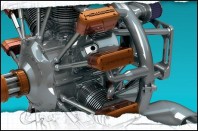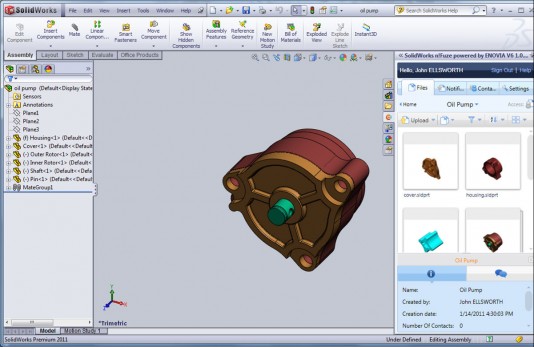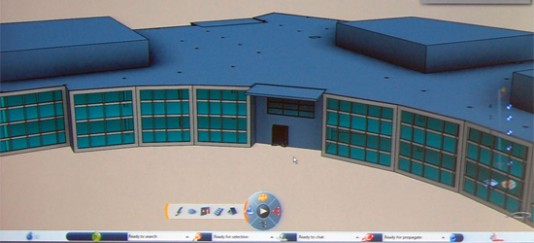Two well-known engineering software industry analysts team up to rate the most promising new products on display at SolidWorks World 2011.
By W. Bradley Holtz and L. Stephen Wolfe, P.E.
 There’s always lots of news at SolidWorks World. SolidWorks demonstrated improvements to its core CAD software that will appear in the 2012 release and introduced a new CEO. Third-party software developers and hardware manufacturers announced improvements to their products from improved high-speed machining algorithms for SolidCAM to Gold Partner status for InspectionXpert.
There’s always lots of news at SolidWorks World. SolidWorks demonstrated improvements to its core CAD software that will appear in the 2012 release and introduced a new CEO. Third-party software developers and hardware manufacturers announced improvements to their products from improved high-speed machining algorithms for SolidCAM to Gold Partner status for InspectionXpert.
After soaking up as much of the news as we could, we (Cyon Research CEO Brad Holtz and industry analyst Steve Wolfe) identified what we think are the most significant new technologies revealed at the event. Here is a brief description of each in rough order of importance:
TS Elements for SolidWorks

T-Splines is an innovative and powerful tool for designing free-form surfaces. It affords designers an exceptional level of control over surface shapes that can’t be achieved with NURBS alone. Curvature continuity (C2) between surfaces is assured automatically.
Heretofore T-Splines has been available as a Rhino add-in. But Rhino is a surface-modeling application. Complete engineering packages require solid models. Importing surfaces into solid-modeling systems requires extra steps at best and may be problematic if surfaces contain holes, gaps, or inverted normal vectors. TS Elements for SolidWorks is a $499 add-in program that enables SolidWorks customers to manipulate surfaces of solid part models with much greater control than they have had before. SolidWorks models that incorporate T-Splines may be viewed, measured, milled, and revised by customers who don’t have the add-in software. The add-in is required to make changes to the T-Spline surfaces.
Caveats: TS Elements won’t assure C3 continuity, if you need that.
Contact: www.tsplines.com
SolidPartners 4g:PLM
SolidWorks Enterprise PDM has turned out to be a good system for storing and organizing SolidWorks models and drawings at companies with multiple offices geographically separated. But except for products developed in the 19th century, complete engineering document packages incorporate more than just SolidWorks drawings and models. Often these documents originate in departments that don’t use SolidWorks and don’t have access to Enterprise PDM. For this reason, activities such as document control, engineering-change management, and cost estimation are better handled in systems that can incorporate all the documents and software that define the product.
Such systems are often referred to as “product lifecycle management” (PLM) systems. One of the best is Agile. But since Agile has been acquired by Oracle, the software has become unavailable to companies that don’t employ Oracle’s database software. At approximately $3,000-per-user to start, it is generally unaffordable for most small and mid-sized firms.
4g:PLM is a new product from SolidPartners that performs the most important functions of Agile for a fraction of the cost. It is relatively simple to set up, affordably priced, and designed from the ground up with new technologies that facilitate sharing data across long distances. This product is so well designed that you should not buy any PLM software until you have seen 4g:PLM.
Although the product is new, SolidPartners has been around for more than a decade. The company was formed in 1997 as a SolidWorks CAD consultancy and to market a CAD-model-management application for SolidWorks originally developed by Agile. At the height of the dot-com boom, when Agile decided it no longer wanted to manage CAD models, it spun off the product to former employees who then changed the name to Activault. Activault predates both the original PDMWorks and PDMWorks Enterprise. That it continues to exist is testament both to the quality of the software (customers love it) and the dedication of the SolidPartners team that supports and develops it.
The first four licenses of 4g:PLM are free if you host it on SolidPartners’ servers. Additional licenses or licenses installed on your own server are moderately priced at $400 per user.
Caveats: 4g:PLM is new, and SolidPartners is not a billion-dollar software firm.
Contact: [email protected]
n!Fuze

At SolidWorks 2010, the company demonstrated a prototype software service for viewing and exchanging files on servers shared on the Internet (often called “cloud servers”). At the time it was called “Product Data Sharing.” A year later, a more refined version, dubbed n!Fuze, is currently being refined in “private beta” testing. A public beta test is expected to begin in one or two months.
Caveat: Fees for the new service haven’t been announced.
Contact: To participate in the public beta, write [email protected].
DraftSight

For 15 years, SolidWorks customers who also create or maintain 2D AutoCAD drawings had to have or purchase AutoCAD or AutoCAD LT in addition to SolidWorks. In 2010, SolidWorks began beta testing new software based on technology obtained from Gräbert, a German company that makes drafting software that reads and writes AutoCAD files. More than 80,000 copies have been downloaded and activated since July.
The new DraftSight software (which is not the same as the former DWGEditor from SolidWorks) made its first appearance at SolidWorks World this year. It is, and will continue to be, free to anybody, whether or not they are SolidWorks customers. SolidWorks plans to charge for support contracts and a version with an API for running other applications. DraftSight is functionally similar to AutoCAD LT (which costs $804 on Amazon Marketplace plus $195 for annual subscriptions). At SolidWorks World, Gräbert announced plans to open a so-called “app store” in April to sell third-party software that automates specific drafting functions on DraftSight.
Caveats: DraftSight lacks the dynamic blocks of LT. The user interface doesn’t employ the ribbon-bar style found in recent AutoCAD releases. There are a few, esoteric incompatibilities with real AutoCAD, and AutoCAD will bark at customers who have saved DWG files in DraftSight. My tests have not demonstrated that DraftSight damages AutoCAD files.
Contact: http://www.3ds.com/products/draftsight/draftsight-overview/
Bunkspeed in the cloud
In August, Bunkspeed incorporated Nvidia Mental Images’ Iray into its realistic rendering software. (“Bunkspeed Shot debuts as first Iray end-user application.”) at SolidWorks World, Bunkspeed previewed a web version of its Iray rendering application that runs on cloud servers equipped with nVidia graphics processors. The software will enable CAD users to produce physically accurate renderings quickly without buying nVidia’s top-of-the-line graphics subsystems. Pricing for the service hasn’t yet been finalized or announced.
More info: http://www.bunkspeed.com/news/news_cloud.html
Zygote human models for SolidWorks
 Zygote Media Group produces exquisitely detailed computer models of human anatomy. Some models include internal organs and skeletons as well as external features. Heretofore, Zygote’s models have been a little pricy for designers who use SolidWorks. At SolidWorks World, the company introduced a low-cost version of its models that can be imported directly into SolidWorks assemblies and positioned as needed to check ergonomics, accessibility, or just give interest to 3D models large enough to incorporate people. Figures may be scaled from the 5th to 95th percentile in size (sorry Michael Jordan) and placed in a variety of anatomically possible positions. The library costs $500. Annual subscriptions that will include new types of figures such as nurses, policemen, etc. are $200. A 15-day free trial is available.
Zygote Media Group produces exquisitely detailed computer models of human anatomy. Some models include internal organs and skeletons as well as external features. Heretofore, Zygote’s models have been a little pricy for designers who use SolidWorks. At SolidWorks World, the company introduced a low-cost version of its models that can be imported directly into SolidWorks assemblies and positioned as needed to check ergonomics, accessibility, or just give interest to 3D models large enough to incorporate people. Figures may be scaled from the 5th to 95th percentile in size (sorry Michael Jordan) and placed in a variety of anatomically possible positions. The library costs $500. Annual subscriptions that will include new types of figures such as nurses, policemen, etc. are $200. A 15-day free trial is available.
Caveat: Requires SolidWorks 2009 or later
Contact: http://www.3dscience.com/humanfactors
Intel’s integrated graphics workstation chip
Intel previewed a forthcoming version of its Xeon E3-1200 microprocessor family including integrated graphics optimized for 3D CAD. The new chips will incorporate 4 regular Xeon microprocessor cores plus two dedicated 3D graphics cores. When the chips are incorporated into workstation motherboards, users of SolidWorks and other 3D CAD software will no longer have to buy separate 3D graphics adapters to get good performance even with real-time shading.
Caveats: Just how affordable the new workstations will be depends on the workstation vendors. And Intel has not yet announced prices or performance data for the new chips, which are still 30 to 60 days from the market. The demonstration model Intel showed at SolidWorks World lacked dual-display ports, a must for new CAD workstations.
Contact: There is no information online yet.
Liquid-cooled workstations
Heat has been the enemy of computer performance since the days of water-cooled mainframes. Until recently, most desktop workstations have been air cooled. When customers employ computationally intensive tasks, such as finite element analysis, workstations may give warning messages or shut down altogether because of overheating.
At SolidWorks World, Hardcore Computer introduced the Detonator Workstation, a liquid-cooled Intel Xeon powered workstation with high performance graphics options. Hardcore claims the new workstation is more reliable under heavy sustained loads than its air-cooled competitors. Equipped with a six-core 3.33-gigahertz Xeon 5680 processor, an Nvidia Quadro 4000 graphics adapter, 6 GB of RAM, and a 1.5-terabyte hard drive, the Detonator costs $6,831 sans monitors. Shipments are expected February 21, 2011.
Caveats: Whether the improved reliability will be worth the cost remains to be seen.
Contact: http://www.hardcorecomputer.com/workstations/detonator/index.html
SolidWorks unveils architectural application

Although intended for the design of manufactured products, SolidWorks has been used in and around architectural and construction design for years. At SolidWorks World, marketing manager Neil Cooke demonstrated an entirely new Dassault Systèmes software product specifically for architectural design and facilities planning. Dubbed Live Buildings, the software resembles Autodesk’s Revit in that it enables architects and facilities engineers to model building structures in 3D. The software includes architectural elements such as floors, roofs, door, windows, and curtain walls. It will be sold through specially qualified SolidWorks AEC resellers.
Caveats: It has taken Autodesk years to turn Revit from a cool concept to a production design tool. Cooke’s demonstration didn’t reveal whether Live Buildings does enough to be useful in real-world construction projects.
Spec-driven piping design for SolidWorks
SolidWorks routing helps automate the design of piping systems, but it doesn’t check whether piping designs deviate from the piping and instrumentation diagrams that define fluid systems. CAD Partner’s Smap 3D assures that piping diagrams and routed systems always agree. It also enables engineers to specify pipe pressure and material classes on P&ID, and then automatically selects the correct pipe weights and fittings to match the spec. Smap’s process is the efficient way to design piping systems.
One need not buy SolidWorks’ routed systems option to take advantage of Smap’s capabilities. An optional add-in generates 2D isometric spool drawings with parts lists. Smap 3D was originally developed for Siemens Solid Edge software and has recently been adapted to SolidWorks. A node-locked license for a complete system costs €9,320. CAD Partner is seeking SolidWorks resellers in the US market.
Caveats: It takes organization to use Smap 3D well. Design houses that must employ a variety of customers’ proprietary piping specifications may not realize the full benefits.
Contact: http://www.smap3d.com/index-en.html
W. Bradley Holtz is CEO of Cyon Research, the company behind the well-known annual COFES conference. L. Stephen Wolfe, P.E. is a Contributing Analyst for both Cyon Research and Jon Peddie Research. He is the founder of the former CADreport and CADCAMNet publications, later acquired by Jon Peddie Research, publisher of GraphicSpeak.





